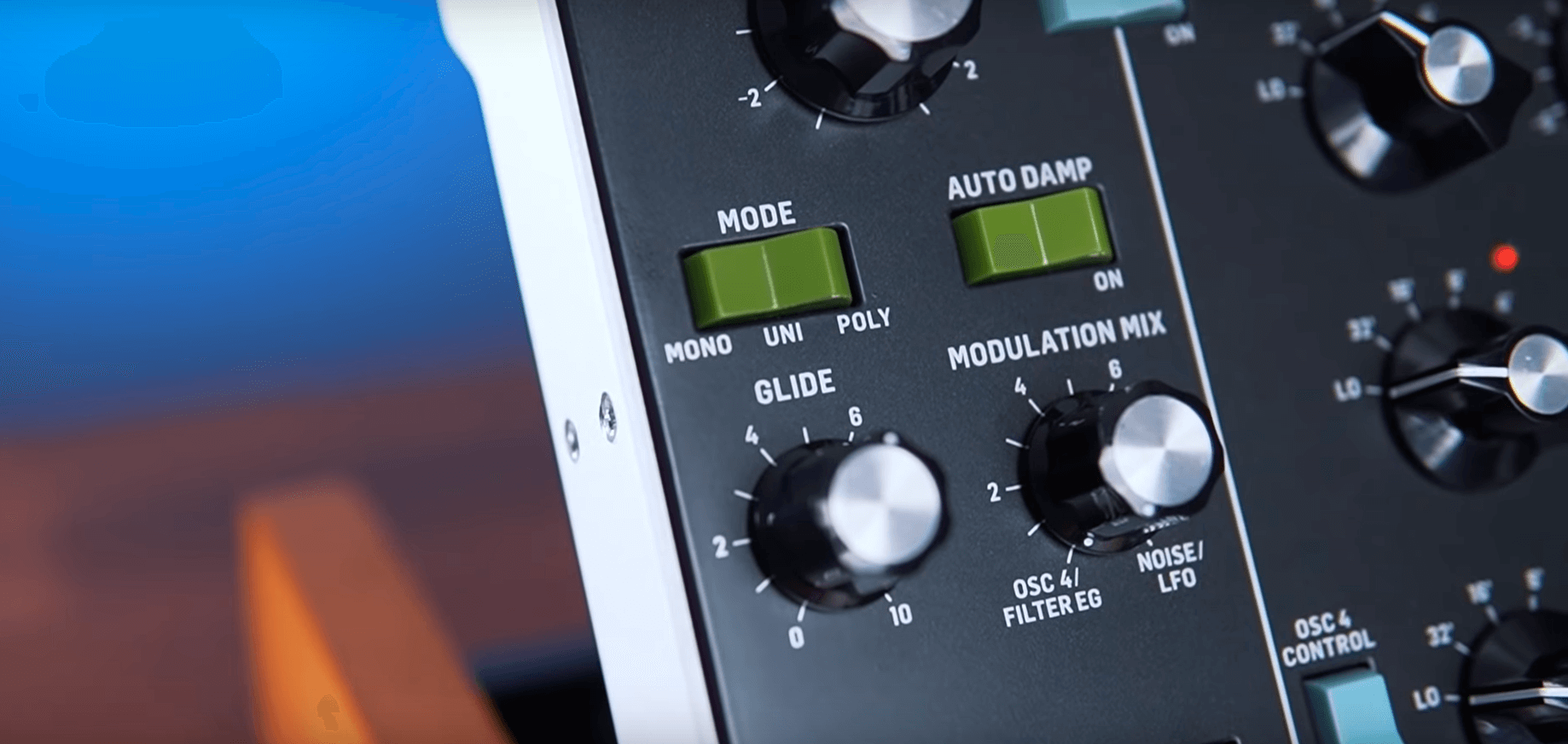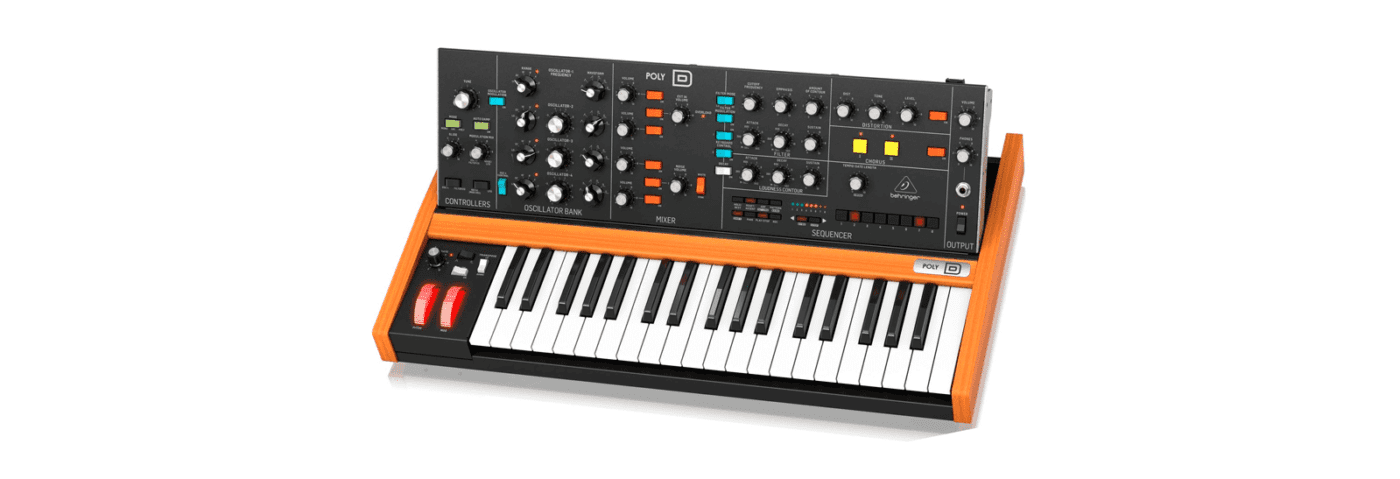Here’s a question for you: when is a polyphonic synth not a polyphonic synth? Answer: when it’s a Behringer Poly-D.
Deep down inside, we all knew it was too good to be true. How could Behringer make a 4 voice polyphonic analog synth based on the Moog Model D for under £700? Well, spoiler alert, they can’t. But that hasn’t stopped them calling it the “Poly-D’ in a vain attempt to distract you from the fact that it is actually a 4 voice ‘paraphonic’ synth.
I know, I know, some people will say I’m knit-picking. Even a paraphonic for $700 is great value. So let’s be clear, there’s a big difference in what you can do with a polyphonic vs a paraphonic synth. Because after all, if you fall for the marketing trick, you wouldn’t want to be disappointed when it arrived and it didn’t work the way you expected it to now, would you?

To clarify the difference for those who haven’t come across a paraphonic synth before (and to be fair, there aren’t many paraphonic synths out there to come across), it’s all in the way it sounds when the notes overlap. A true four-voice poly has four of everything, four filters, four amps, four modulation envelopes etc. In contrast, a paraphonic has four oscillators, but only one filter and one amp, etc. It begs the question: did someone at Behringer say “honestly…guys…we should call this the ‘para-d'” and everyone in the room laughed at them and replied “but that’s exactly what we are doing! We’re producing a parody of the real thing”.
So what’s the difference then? The short answer is, para is more limited and doesn’t sound the same as poly, otherwise we wouldn’t need the different terms to describe them; obvs.
To work around this, the Poly-D has three playing modes; Mono, Uni(son) and Poly.
Mono mode works like a four oscillator synth, switch on whichever oscillators you want to hear, tune to whatever intervals you like and play single notes. It works as expected.
Where things start to get a little odd is when you select Uni or Poly.
With Uni, it behaves the same as Mono when you play a single note; it triggers all four oscillators in a nice big fat unison. But this can start to sound inconsistent if you have different intervals and octaves tuned for any of the oscillators. So, to make it consistent, you need to tune all the oscillators to the same note, otherwise, you will hear your chords jumping around different octaves as it cycles through the oscillators allocating voices.
The third mode is Poly, which sounds like the mode you would want to use if you paid money for a polysynth. Again, the important thing here is, if you want the notes you play to be the notes you hear, you have to tune all oscillators to the same note (and probably the same waveform), otherwise you will get inconsistencies in tone and pitch as the synth cycles through the different oscillators to allocate the voices.
Even for around £700, I’m not getting the poly synth that I want or is advertised.
Now, it’s not just voice allocation that makes a difference. Remember when we said it only has one amp and one filter and one filter envelope? Well, if you have the amp envelope set to a slow attack and long release, then the second note you play will start without the slow attack.
And that’s just the beginning of how the limitations of paraphonic compare to the freedom of true polyphonic. If you hold a note down and then quickly play other notes over the top, they will just cut in and out, completely unaffected by the release section of the amp. How do you like that then? This is because it just uses a hard gate to trigger the secondary notes. So, how about a workaround then? Sure, just engage the ‘auto-damp’ mode, and this will sustain any of the secondary notes until you release the initial note, at which point the Amp envelope will move to the release section and all notes will fade out. So Auto-Damp kind of works for chords, but can make a mess out of anything that has a bit of legato.
The problem with having a single envelope continues with the filter section. Without individual filters and envelopes for each voice, we get the same issues as we did with the amp section. So again, it’s a case of buyer be aware.
Could I rant on for another few paragraphs about the extremely limited modulation options or the weird stuff that happens when you try to use Osc 4 as a modulator in poly mode? Possibly, but I will concede that I do like the lighting on the pitch and mod wheels but just not enough to buy the damn thing. Even for around £700, I’m not getting the poly synth that I want or is advertised.
So what does it sound like? Given the deception with the name, and it’s not a real poly, I don’t care what it sounds like. Out of principle, it’s a hard pass for me. Sure, it’s got a couple of chorus modes lifted from the Juno and a distortion unit, but without a mix knob, we are back to the land of take it or leave it. So on that note, I’ll leave it. Thanks all the same but I’d rather Behringer turn their attention to cloning a Mac. Now that’s a court case I’d tune into.
This article was definitely not written by Marc Adamo.

08.04 PM
The author of this poor article seems o be a cry baby. Maybe didnt get enough milk from his mum as a baby… who knows… or cares? 🙂